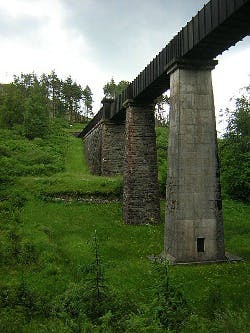The company explained that the two aqueducts are essential for the normal operation of the Milngavie and Balmore water treatment works just north of Glasgow, which produce around 550,000 m3/day of water.
According to Scottish Water the £7 million capital maintenance project has improved the security of the water supply to customers and is the biggest upgrade to the aqueducts since they were built over 150 years ago.
The original aqueduct includes tunnels through mountainous terrain in the shadow of Ben Lomond and bridges over the valleys of the Duchray, Endrick and Blane watercourses. A second aqueduct was constructed to accommodate the rapid expansion of Glasgow in the late 19th century.
The project included structural repairs and improvements to miles of tunnels and 21 bridges along the route of the aqueducts, which distribute raw water by gravity, as well as repairs and refurbishments of control valves.
A section of the aqueduct was closed for the first time in living memory during the project but, according to Scottish Water, through the use of cross-connections in its system, it was able to maintain normal water supplies to customers.
The company also noted that many of the bridge structures are located deep in heavily forested areas of the Loch Lomond & the Trossachs National Park, with limited access meaning temporary accesses were required to accommodate the delivery of large amounts of scaffolding.
Further challenges were presented in the tunnels, where access for repairs required the transportation of workers, equipment and materials up to 0.6 miles (965 metres) in confined spaces. To tackle this, the company said that an innovative adaptation of a golf buggy provided the principal means of transport.
“These aqueducts, which were part of a scheme opened by Queen Victoria in 1859, were a feat of engineering of their day and remain an outstanding example of sustainable civil engineering public works construction, which have stood the test of time,” said John Rae, Scottish Water’s general manager of water operations.
“But, despite some improvement work over the years, they required substantial capital maintenance to ensure they continue to operate efficiently,” he added.
Historic importance
Over the combined length of the old and ‘new’ aqueducts, the company explained that there are more than 30 historic listed structures and planning permission for the repair work was conditional on full consultation with Historic Scotland.
Further to this, work on a bridge over Endrick Water, a site designated as a Special Area of Conservation by Scottish Natural Heritage for its population of Atlantic salmon and lamprey, required special protective measures to prevent silting of the watercourse.
According to Simon Renton, Scottish Water’s project manager, strict adherence to constraints and restrictions was necessary to ensure that the character of the historic structure was preserved.
“Reconstructed areas of masonry on every part of the structure had to match the existing stonework in terms of appearance and painting and protective coating systems were carefully chosen to blend with the surrounding structure,” he explained.
The capital maintenance work, which started last September, was carried out for Scottish Water by contractors George Leslie.



